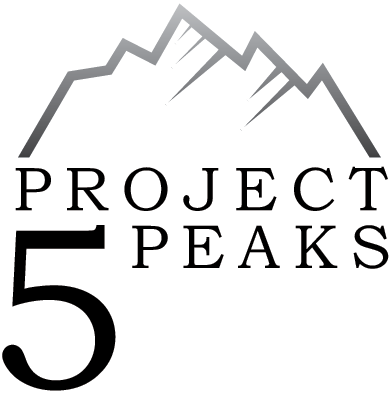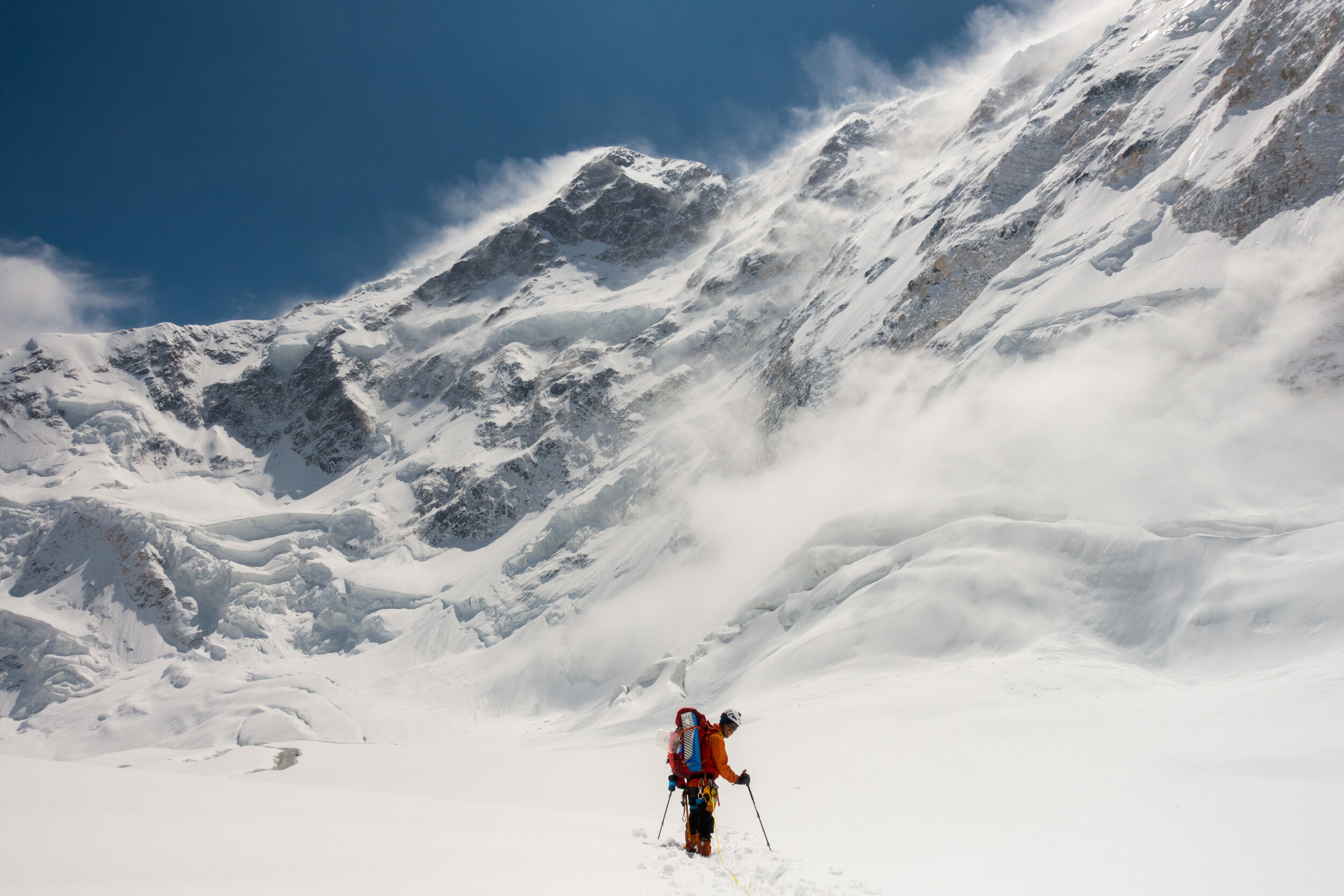Pobeda part III - 'hail mary'
Text by Gijs Schuurhuis
Photos by Martin Vorel
As we descended the weather improved and by the time we reached the glacier we were once again making our way through soft and deep snow. We got to ABC, spent the night there and made our way to basecamp the following day. While sitting in front of our tents we looked at an extremely calm Pobeda. A single cloud hanging perfectly still, just hoovering above the summit pyramid. The next day a team of Belarussians summited and in the days after a Russian team also made it to the summit. Frustrating for us, but a great success for these teams!
Back in basecamp we immediately started checking the weather reports to find a summit window. There are some good online weather forecasts that we use, such as MeteoBlue and Mountain Forecast, however in the mountains you can’t really rely on these reports. A mountain always has its own weather system, especially when it’s as big as Pobeda! So it’s about combining all of the data and reports, calculating risks, a lot of discussions and in the end listening to your gut feeling.
Two days passed by and the reports kept changing. Overall it just didn’t look good at all with a general outlook of a lot of snow and strong winds with some windows here-and-there. Martin was skeptical and both Allert and myself in doubt, but in the end we saw our expedition coming to an end and decided to go for our hail Mary attempt. We started packing our bags with food for about 11 days to sit out bad weather if we had to. The next day we reached the end of the moraine, repacked our bags and divided the stuff we left behind last time we were there.
The big Russian team made a new route through the glacier, leaving small flags every now and then. It was a great route which led us through the icefall in few hours, directly to ABC. We skipped this camp to get a little closer to the icefall and pitched our tents in a flat area. The next day we woke up early and with the big packs started making our way towards the icefall. The frozen snow made our progress pretty fast and in the light of our headlamps we made it to the wall of ice. It’s funny how climbing in the dark eases the mind. In a way it relieves you of the anxiety of being in a scary place. It’s a feeling of serenity, calm but heavy breathing and just a small beam of light guiding you up.
We got through the icefall and crossed the snow bridges and crevasses, which at this point, due to the warmth were much bigger and scarier than before and covered with fresh snow. The endless snow slopes started, but we were much earlier than last time and the snow was still frozen. We made good progress and only a few hundred meters below C1 the sun came. After that it was pure hell. Back down below we agreed on skipping camp and go straight to the camp at 5.600m. Climbing the icefall, plowing through snow and taking in a 1.200m climb, we knew it was going to be a big day.
My energy was drained as we reached C1, to be honest, I was absolutely shattered and there was still a good 600m to climb. At this point the sun was blazing. Me being the slowest, I took lead and the guys followed. Step by step we made it to camp 5.600m. Upon arrival we were all f*cked, Martin took his mattress and starting sleeping, I walked around like a zombie kicking over the tea Allert was making. I can say that for sure this day will rank pretty high in most intense mountain days I’ll ever encounter.
We pitched our tent, got into our sleeping bags and listened to the radio. The day before a Turkish team was telling they made it to the summit, but were still high on the mountain. There was a big Russian group and a Czech group at 6.400m. As the winds picked up we heard a lot of Russian talk over the radio, but no news from the Turkish or the Czech. We settled down for the night and knew that a storm was coming. We could already see the strong winds hitting the higher parts of the mountain and realized it must be hell to be there right now.
That night a lot of snow came down and by morning we looked outside and we were in a complete whiteout with at least 30cm of fresh snow. High up the mountain jet winds where blazing. We discussed our options and made the decision to wait for an hour. After an hour we waited for another hour and then we switched on the radio. We heard the Turkish team in panic as they lost a tent due to the wind, somebody got sick and they were unable to go down in these strong winds. Since Martin can understand a little bit of Russian we also heard that all Russians were coming down. Now, you have to understand that Russian climbers have a different perspective on risks. So if all of them are going down, it means you have to get the hell out of there!
It seemed our hail Mary attempt was coming to an end and so we shifted our focus on getting back down safely which would prove to be a challenge. In a complete whiteout with no track whatsoever we roped up and started making our way down. Even though we had a GPS-tracker it’s still a scary situation. All crevasses were covered in fresh snow, by now the avalanche risk was high and with big drops left and right we took precautionary measures. Most avalanches are not triggered by the first person to cross an unstable snowfield, but rather by the second or the third. On the other hand the risk of the leader falling into a crevasse seemed even more likely. In the end we opted to for one of us taking the lead on a extended rope and two of us followed with enough spare rope to make an fast crevasse rescue when needed.
Martin took lead, we were all anxious, but everything went reasonably smooth, until we found out the GPS didn’t track the entire way to C1. We found a big serac and went around it. Martin continued when all of a sudden we heard a deep crack and in a split second I thought the snow around us started moving. We all stopped and tried not to panic. Martin was looking at his cellphone, which didn’t give a clear direction to follow. Moving forward just didn’t feel wright, We made an educated guess and went east climbing a up a small snow slope. Twenty minutes later we saw what we thought was C1. After a few hundred meters we passed a big serac and saw a small snow slide. It hit us that this slide was the earlier crack we had heared and that Martin had stood on the edge of a serac and almost had taken a big fall! Arriving at C1 the weather had cleared and we were all relieved.
Even though it was late in the morning we wanted to get the hell out of there, because of the continuing bad weather and chose to descent all the way down. Another endless journey through slushy snow started. By now I was tired and clumsy, I must have tripped a hundred times. Falling through snow bridges into small crevasses – it was terror. Allert and Martin seemed fine, so we continued. I remember clipping into the fixed rope, I was first to abseil down the big serac into the icefall. I put my weight on the rope and as I stepped into the void a medium sized avalanche went down about 20 meters to right of me. By now I just wanted to get down, I abseiled as fast as I could, unclipped and ran across the snowfield to safety. I reached the big black stone, which would shelter me from any avalanche danger and waited for Martin and Allert to join. When Allert reached the bottom of the abseiled he was hit by falling ice from the serac, but luckily not injured.
We made it down safely to glacier. We took a few minutes to look at Pobeda and take it all in. It was a big moment after an epic descent. Then we roped up and made our way across the glacier, to basecamp - home.




